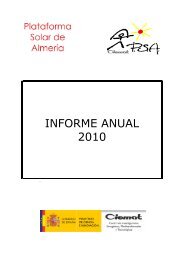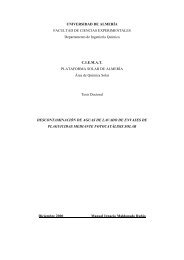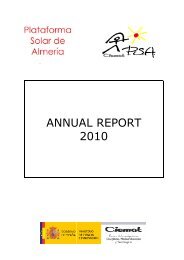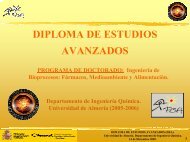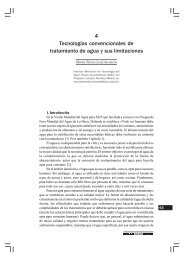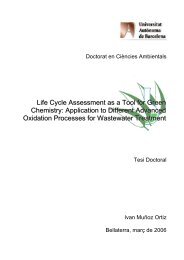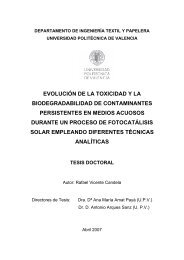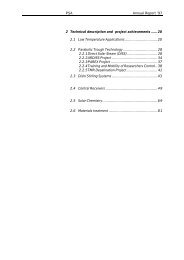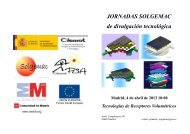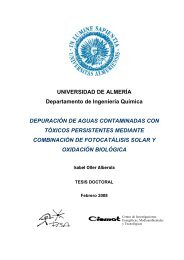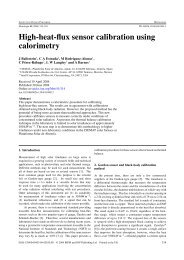Annual Report 2006 - Plataforma Solar de AlmerÃa
Annual Report 2006 - Plataforma Solar de AlmerÃa
Annual Report 2006 - Plataforma Solar de AlmerÃa
You also want an ePaper? Increase the reach of your titles
YUMPU automatically turns print PDFs into web optimized ePapers that Google loves.
ENVIRONMENTAL APPLICATIONS OF SOLAR ENERGY<br />
4.2.1 FOTODETOX<br />
Elimination of persistent pollutants by advanced oxidation.<br />
http://www.psa.es/webesp/projects/foto<strong>de</strong>tox/in<strong>de</strong>x.html<br />
Participants: Univ. of Almería Dept. of Chemical Engineering; Polytechnic<br />
Univ. of Valencia Dept. of. Textile Engineering; CIEMAT-PSA (coordinator).<br />
Contact:<br />
Funding:<br />
Dr. S. Malato, sixto.malato@psa.es<br />
National RD&I Plan, MEC. CIEMAT budget: 80 K€ + 1 FPI Ph.D.<br />
Fellowship.<br />
Duration: December 2003 – December <strong>2006</strong><br />
Motivation:<br />
Treatment of water containing pestici<strong>de</strong>s by combined biological<br />
and photocatalytic treatment.<br />
Purposes:<br />
1) Pilot-plant solar photocatalytic (photo-Fenton and TiO2) treatment of<br />
water containing pestici<strong>de</strong>s. Find optimum operating parameters.<br />
2) Study of bio<strong>de</strong>gradability using monospecific bacteria cultures (selected<br />
from among those commonly used in WTPs) in pestici<strong>de</strong>polluted<br />
water partly treated by photocatalysis. Evaluation of the bacteria<br />
strains that are the most active in bio<strong>de</strong>grading pollutants.<br />
3) Development of predictive mo<strong>de</strong>ls for bio<strong>de</strong>gradability of water partly<br />
treated by photocatalysis.<br />
4) Study of the bio<strong>de</strong>gradability (using real activated sludge from WTPs)<br />
of pestici<strong>de</strong>-polluted water partly treated by photocatalysis.<br />
5) Development of a bioreactor specially adapted to this kind of water<br />
partly treated by photocatalysis.<br />
6) Pre<strong>de</strong>sign of a solar photocatalytic water treatment plant for pretreating<br />
water containing persistent pollutants and make them compatible<br />
with municipal WTP input requirements.<br />
Objectives achieved in <strong>2006</strong>:<br />
The objectives set for 2004 and 2005 were met (see PSA <strong>Annual</strong> <strong>Report</strong>s<br />
2004 and 2005), and during <strong>2006</strong>, work was mainly related to Objectives 4, 5<br />
and 6.<br />
Biological processes are among the simplest and economical treatment<br />
techniques available, and it therefore makes good sense to combine them<br />
with photo-Fenton, since the <strong>de</strong>gradation of non-bio<strong>de</strong>gradable pollutants is<br />
normally coupled with both reduced toxicity and increased bio<strong>de</strong>gradability.<br />
Our proposal is a combination of quick analysis techniques (COD, TOC, toxicity)<br />
that would assist in making a <strong>de</strong>cision as to which parameters to use for<br />
estimating or measuring the bio<strong>de</strong>gradability of water. Once the plant is in<br />
continuous operation, just one of the above parameters might even be<br />
enough for an experienced operator to make this <strong>de</strong>cision.<br />
Below we propose a working methodology for fast techniques to predict<br />
when water is bio<strong>de</strong>gradable. One of these parameters is called “Average Oxidation<br />
State” (AOS), which can be calculated by the following equation, where<br />
TOC (Total Organic Carbon and COD (Chemical Oxygen Demand) are expressed<br />
in moles of C L -1 and O 2 L -1 , respectively.<br />
73



